Ketogenesis: Metabolic Pathways, Environmental Factors, and Outcomes
VerifiedAdded on 2022/12/12
|6
|1484
|100
Report
AI Summary
This report provides a comprehensive overview of ketogenesis, a biochemical process involving the production of ketone bodies from fatty acids and ketogenic amino acids, primarily used for energy dissemination, especially in the brain. The report details the chemical mechanisms involved in ketogenesis, including the formation of acetoacetyl-CoA and 3-OH-3-methylglutaryl-CoA, and discusses various deficiencies that can disrupt these pathways. It further examines environmental factors that can disrupt these metabolic pathways, such as exposure to artificial compounds and the effects of pharmaceuticals like thalidomide and ibuprofen. The report also explores the consequences of ketogenesis, including the benefits of ketogenic diets in treating neurological disorders and the dangers of elevated ketone levels, which can lead to oxidative stress and increased morbidity. Finally, the report emphasizes the critical role of ketogenesis in energy production and the importance of understanding the various chemical processes and their impact on health, including the condition of diabetic ketoacidosis.
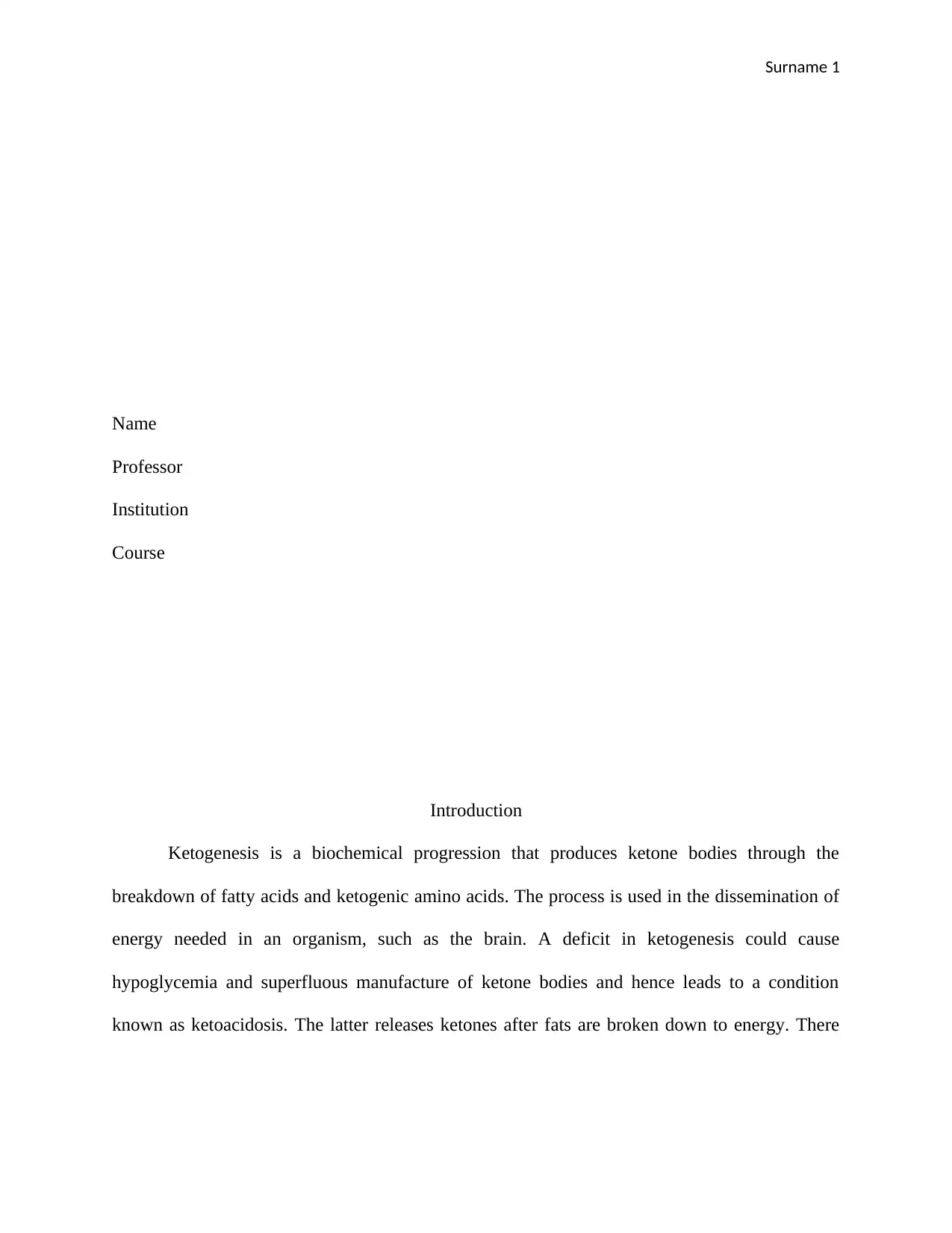
Surname 1
Name
Professor
Institution
Course
Introduction
Ketogenesis is a biochemical progression that produces ketone bodies through the
breakdown of fatty acids and ketogenic amino acids. The process is used in the dissemination of
energy needed in an organism, such as the brain. A deficit in ketogenesis could cause
hypoglycemia and superfluous manufacture of ketone bodies and hence leads to a condition
known as ketoacidosis. The latter releases ketones after fats are broken down to energy. There
Name
Professor
Institution
Course
Introduction
Ketogenesis is a biochemical progression that produces ketone bodies through the
breakdown of fatty acids and ketogenic amino acids. The process is used in the dissemination of
energy needed in an organism, such as the brain. A deficit in ketogenesis could cause
hypoglycemia and superfluous manufacture of ketone bodies and hence leads to a condition
known as ketoacidosis. The latter releases ketones after fats are broken down to energy. There
Paraphrase This Document
Need a fresh take? Get an instant paraphrase of this document with our AI Paraphraser
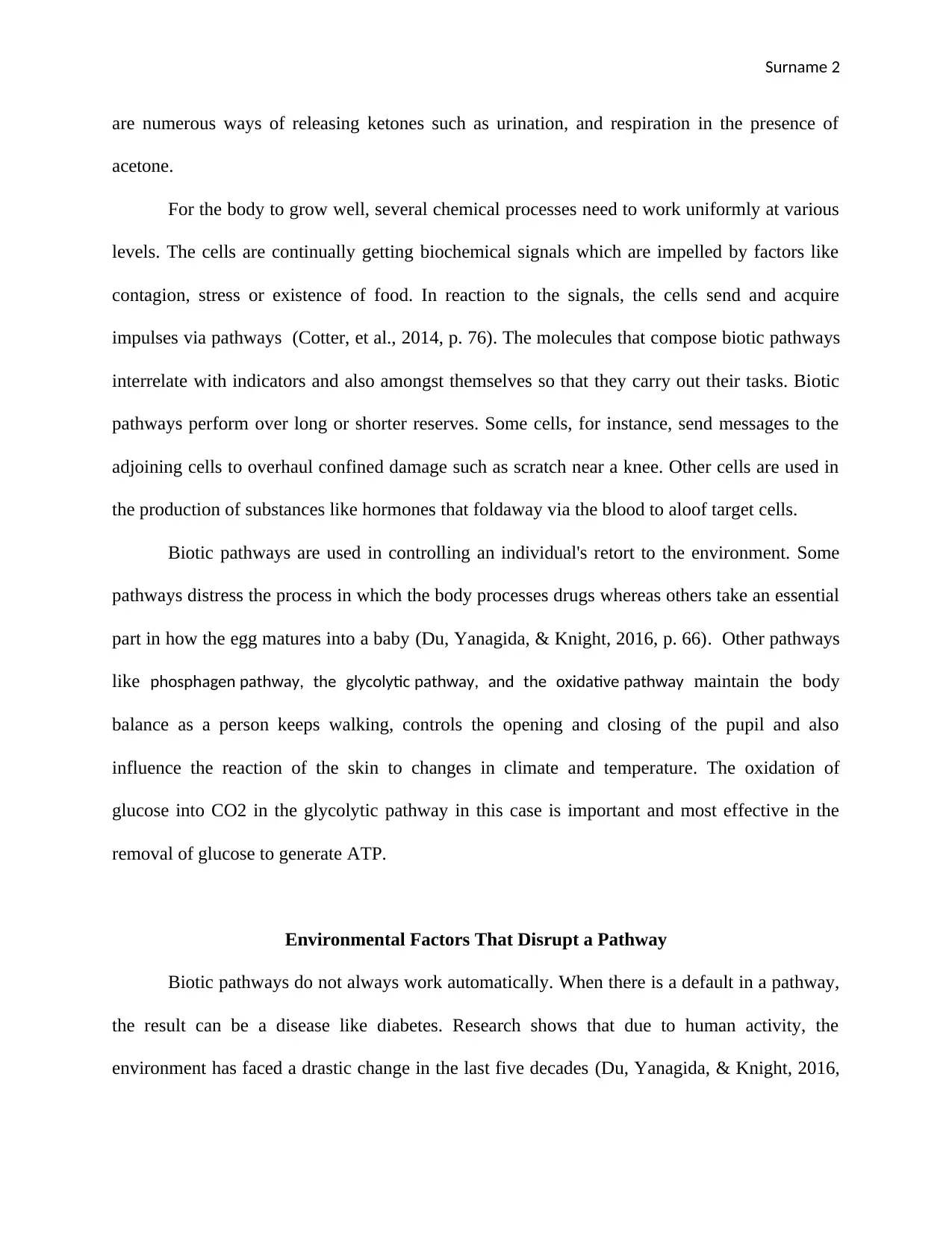
Surname 2
are numerous ways of releasing ketones such as urination, and respiration in the presence of
acetone.
For the body to grow well, several chemical processes need to work uniformly at various
levels. The cells are continually getting biochemical signals which are impelled by factors like
contagion, stress or existence of food. In reaction to the signals, the cells send and acquire
impulses via pathways (Cotter, et al., 2014, p. 76). The molecules that compose biotic pathways
interrelate with indicators and also amongst themselves so that they carry out their tasks. Biotic
pathways perform over long or shorter reserves. Some cells, for instance, send messages to the
adjoining cells to overhaul confined damage such as scratch near a knee. Other cells are used in
the production of substances like hormones that foldaway via the blood to aloof target cells.
Biotic pathways are used in controlling an individual's retort to the environment. Some
pathways distress the process in which the body processes drugs whereas others take an essential
part in how the egg matures into a baby (Du, Yanagida, & Knight, 2016, p. 66). Other pathways
like phosphagen pathway, the glycolytic pathway, and the oxidative pathway maintain the body
balance as a person keeps walking, controls the opening and closing of the pupil and also
influence the reaction of the skin to changes in climate and temperature. The oxidation of
glucose into CO2 in the glycolytic pathway in this case is important and most effective in the
removal of glucose to generate ATP.
Environmental Factors That Disrupt a Pathway
Biotic pathways do not always work automatically. When there is a default in a pathway,
the result can be a disease like diabetes. Research shows that due to human activity, the
environment has faced a drastic change in the last five decades (Du, Yanagida, & Knight, 2016,
are numerous ways of releasing ketones such as urination, and respiration in the presence of
acetone.
For the body to grow well, several chemical processes need to work uniformly at various
levels. The cells are continually getting biochemical signals which are impelled by factors like
contagion, stress or existence of food. In reaction to the signals, the cells send and acquire
impulses via pathways (Cotter, et al., 2014, p. 76). The molecules that compose biotic pathways
interrelate with indicators and also amongst themselves so that they carry out their tasks. Biotic
pathways perform over long or shorter reserves. Some cells, for instance, send messages to the
adjoining cells to overhaul confined damage such as scratch near a knee. Other cells are used in
the production of substances like hormones that foldaway via the blood to aloof target cells.
Biotic pathways are used in controlling an individual's retort to the environment. Some
pathways distress the process in which the body processes drugs whereas others take an essential
part in how the egg matures into a baby (Du, Yanagida, & Knight, 2016, p. 66). Other pathways
like phosphagen pathway, the glycolytic pathway, and the oxidative pathway maintain the body
balance as a person keeps walking, controls the opening and closing of the pupil and also
influence the reaction of the skin to changes in climate and temperature. The oxidation of
glucose into CO2 in the glycolytic pathway in this case is important and most effective in the
removal of glucose to generate ATP.
Environmental Factors That Disrupt a Pathway
Biotic pathways do not always work automatically. When there is a default in a pathway,
the result can be a disease like diabetes. Research shows that due to human activity, the
environment has faced a drastic change in the last five decades (Du, Yanagida, & Knight, 2016,
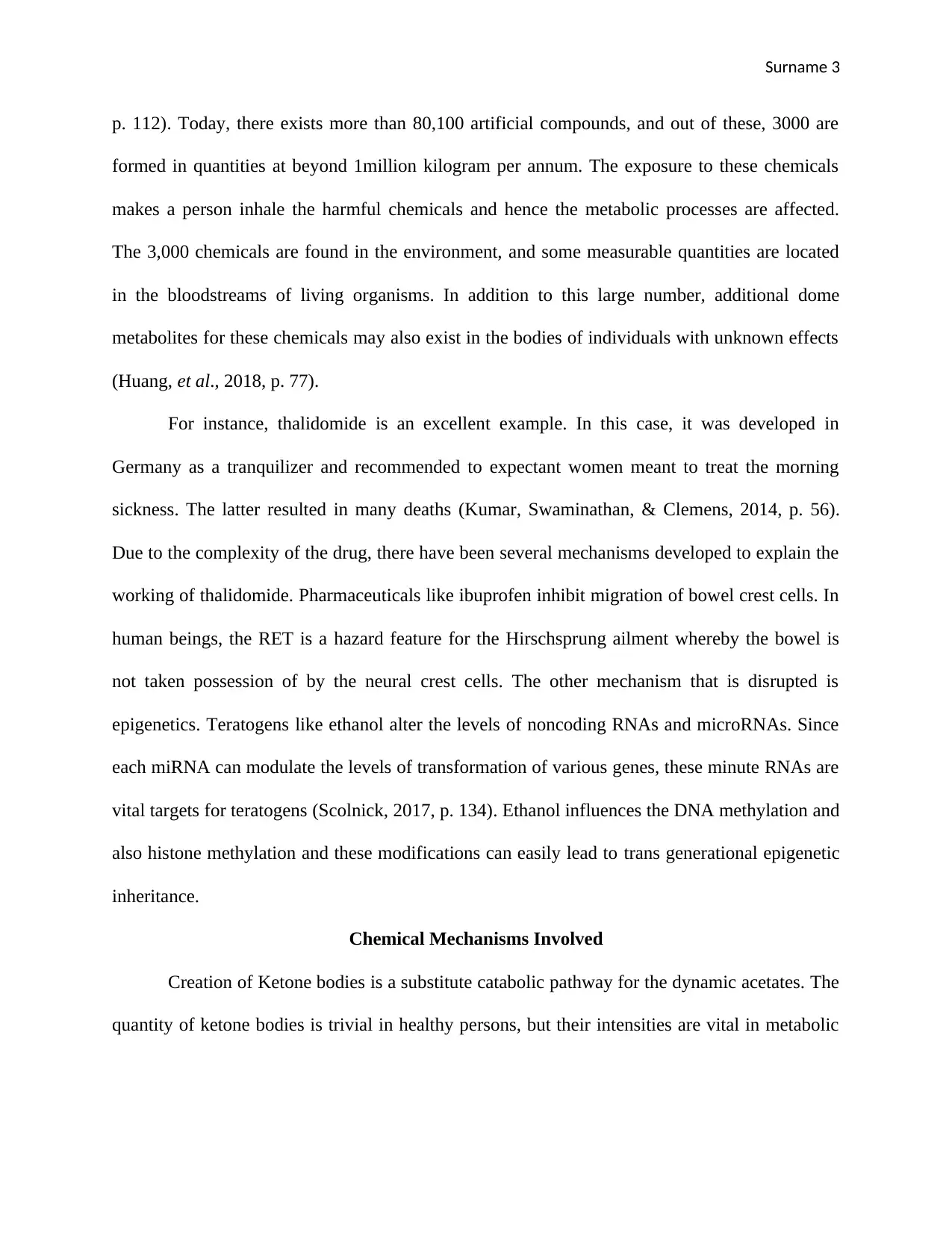
Surname 3
p. 112). Today, there exists more than 80,100 artificial compounds, and out of these, 3000 are
formed in quantities at beyond 1million kilogram per annum. The exposure to these chemicals
makes a person inhale the harmful chemicals and hence the metabolic processes are affected.
The 3,000 chemicals are found in the environment, and some measurable quantities are located
in the bloodstreams of living organisms. In addition to this large number, additional dome
metabolites for these chemicals may also exist in the bodies of individuals with unknown effects
(Huang, et al., 2018, p. 77).
For instance, thalidomide is an excellent example. In this case, it was developed in
Germany as a tranquilizer and recommended to expectant women meant to treat the morning
sickness. The latter resulted in many deaths (Kumar, Swaminathan, & Clemens, 2014, p. 56).
Due to the complexity of the drug, there have been several mechanisms developed to explain the
working of thalidomide. Pharmaceuticals like ibuprofen inhibit migration of bowel crest cells. In
human beings, the RET is a hazard feature for the Hirschsprung ailment whereby the bowel is
not taken possession of by the neural crest cells. The other mechanism that is disrupted is
epigenetics. Teratogens like ethanol alter the levels of noncoding RNAs and microRNAs. Since
each miRNA can modulate the levels of transformation of various genes, these minute RNAs are
vital targets for teratogens (Scolnick, 2017, p. 134). Ethanol influences the DNA methylation and
also histone methylation and these modifications can easily lead to trans generational epigenetic
inheritance.
Chemical Mechanisms Involved
Creation of Ketone bodies is a substitute catabolic pathway for the dynamic acetates. The
quantity of ketone bodies is trivial in healthy persons, but their intensities are vital in metabolic
p. 112). Today, there exists more than 80,100 artificial compounds, and out of these, 3000 are
formed in quantities at beyond 1million kilogram per annum. The exposure to these chemicals
makes a person inhale the harmful chemicals and hence the metabolic processes are affected.
The 3,000 chemicals are found in the environment, and some measurable quantities are located
in the bloodstreams of living organisms. In addition to this large number, additional dome
metabolites for these chemicals may also exist in the bodies of individuals with unknown effects
(Huang, et al., 2018, p. 77).
For instance, thalidomide is an excellent example. In this case, it was developed in
Germany as a tranquilizer and recommended to expectant women meant to treat the morning
sickness. The latter resulted in many deaths (Kumar, Swaminathan, & Clemens, 2014, p. 56).
Due to the complexity of the drug, there have been several mechanisms developed to explain the
working of thalidomide. Pharmaceuticals like ibuprofen inhibit migration of bowel crest cells. In
human beings, the RET is a hazard feature for the Hirschsprung ailment whereby the bowel is
not taken possession of by the neural crest cells. The other mechanism that is disrupted is
epigenetics. Teratogens like ethanol alter the levels of noncoding RNAs and microRNAs. Since
each miRNA can modulate the levels of transformation of various genes, these minute RNAs are
vital targets for teratogens (Scolnick, 2017, p. 134). Ethanol influences the DNA methylation and
also histone methylation and these modifications can easily lead to trans generational epigenetic
inheritance.
Chemical Mechanisms Involved
Creation of Ketone bodies is a substitute catabolic pathway for the dynamic acetates. The
quantity of ketone bodies is trivial in healthy persons, but their intensities are vital in metabolic
⊘ This is a preview!⊘
Do you want full access?
Subscribe today to unlock all pages.

Trusted by 1+ million students worldwide
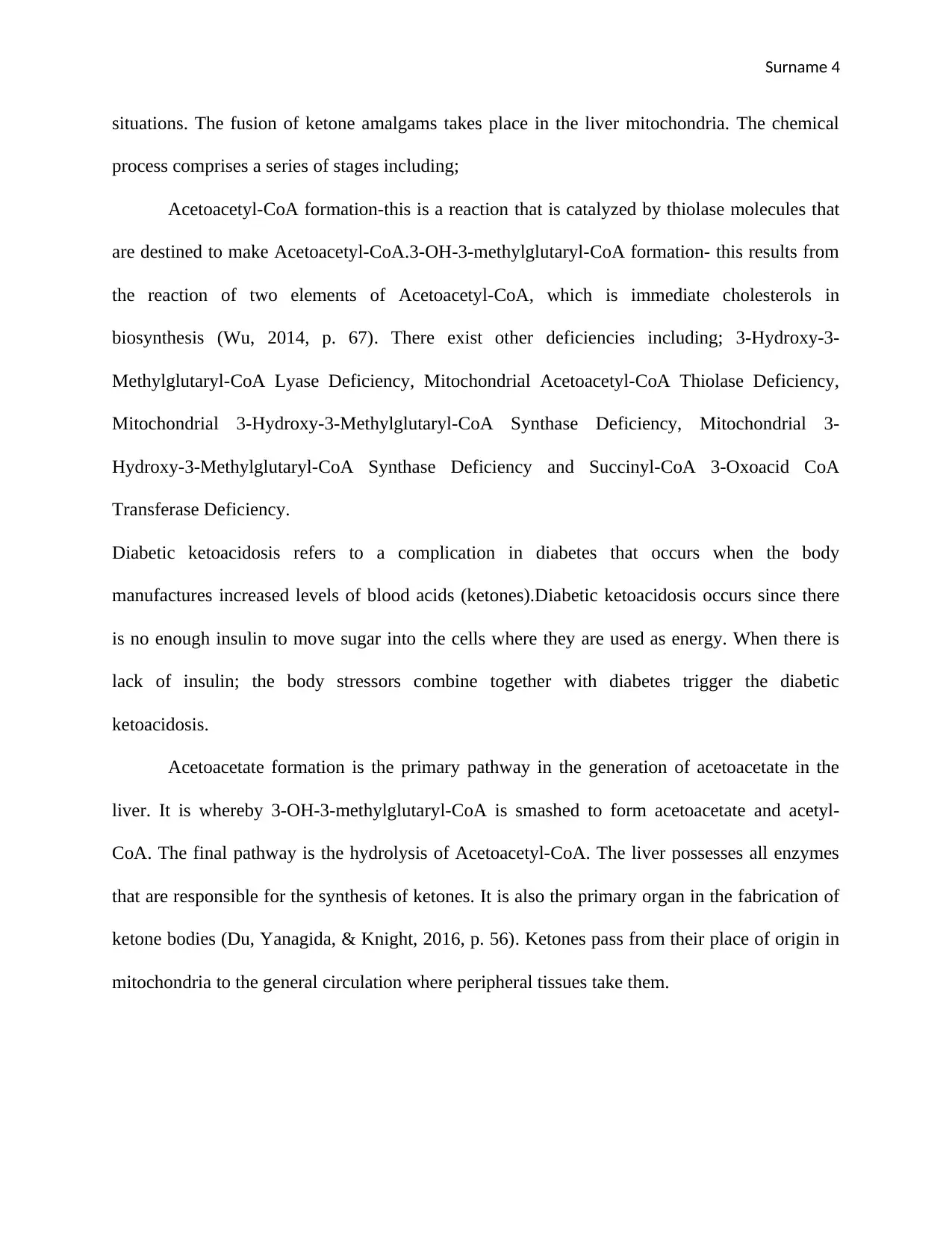
Surname 4
situations. The fusion of ketone amalgams takes place in the liver mitochondria. The chemical
process comprises a series of stages including;
Acetoacetyl-CoA formation-this is a reaction that is catalyzed by thiolase molecules that
are destined to make Acetoacetyl-CoA.3-OH-3-methylglutaryl-CoA formation- this results from
the reaction of two elements of Acetoacetyl-CoA, which is immediate cholesterols in
biosynthesis (Wu, 2014, p. 67). There exist other deficiencies including; 3-Hydroxy-3-
Methylglutaryl-CoA Lyase Deficiency, Mitochondrial Acetoacetyl-CoA Thiolase Deficiency,
Mitochondrial 3-Hydroxy-3-Methylglutaryl-CoA Synthase Deficiency, Mitochondrial 3-
Hydroxy-3-Methylglutaryl-CoA Synthase Deficiency and Succinyl-CoA 3-Oxoacid CoA
Transferase Deficiency.
Diabetic ketoacidosis refers to a complication in diabetes that occurs when the body
manufactures increased levels of blood acids (ketones).Diabetic ketoacidosis occurs since there
is no enough insulin to move sugar into the cells where they are used as energy. When there is
lack of insulin; the body stressors combine together with diabetes trigger the diabetic
ketoacidosis.
Acetoacetate formation is the primary pathway in the generation of acetoacetate in the
liver. It is whereby 3-OH-3-methylglutaryl-CoA is smashed to form acetoacetate and acetyl-
CoA. The final pathway is the hydrolysis of Acetoacetyl-CoA. The liver possesses all enzymes
that are responsible for the synthesis of ketones. It is also the primary organ in the fabrication of
ketone bodies (Du, Yanagida, & Knight, 2016, p. 56). Ketones pass from their place of origin in
mitochondria to the general circulation where peripheral tissues take them.
situations. The fusion of ketone amalgams takes place in the liver mitochondria. The chemical
process comprises a series of stages including;
Acetoacetyl-CoA formation-this is a reaction that is catalyzed by thiolase molecules that
are destined to make Acetoacetyl-CoA.3-OH-3-methylglutaryl-CoA formation- this results from
the reaction of two elements of Acetoacetyl-CoA, which is immediate cholesterols in
biosynthesis (Wu, 2014, p. 67). There exist other deficiencies including; 3-Hydroxy-3-
Methylglutaryl-CoA Lyase Deficiency, Mitochondrial Acetoacetyl-CoA Thiolase Deficiency,
Mitochondrial 3-Hydroxy-3-Methylglutaryl-CoA Synthase Deficiency, Mitochondrial 3-
Hydroxy-3-Methylglutaryl-CoA Synthase Deficiency and Succinyl-CoA 3-Oxoacid CoA
Transferase Deficiency.
Diabetic ketoacidosis refers to a complication in diabetes that occurs when the body
manufactures increased levels of blood acids (ketones).Diabetic ketoacidosis occurs since there
is no enough insulin to move sugar into the cells where they are used as energy. When there is
lack of insulin; the body stressors combine together with diabetes trigger the diabetic
ketoacidosis.
Acetoacetate formation is the primary pathway in the generation of acetoacetate in the
liver. It is whereby 3-OH-3-methylglutaryl-CoA is smashed to form acetoacetate and acetyl-
CoA. The final pathway is the hydrolysis of Acetoacetyl-CoA. The liver possesses all enzymes
that are responsible for the synthesis of ketones. It is also the primary organ in the fabrication of
ketone bodies (Du, Yanagida, & Knight, 2016, p. 56). Ketones pass from their place of origin in
mitochondria to the general circulation where peripheral tissues take them.
Paraphrase This Document
Need a fresh take? Get an instant paraphrase of this document with our AI Paraphraser
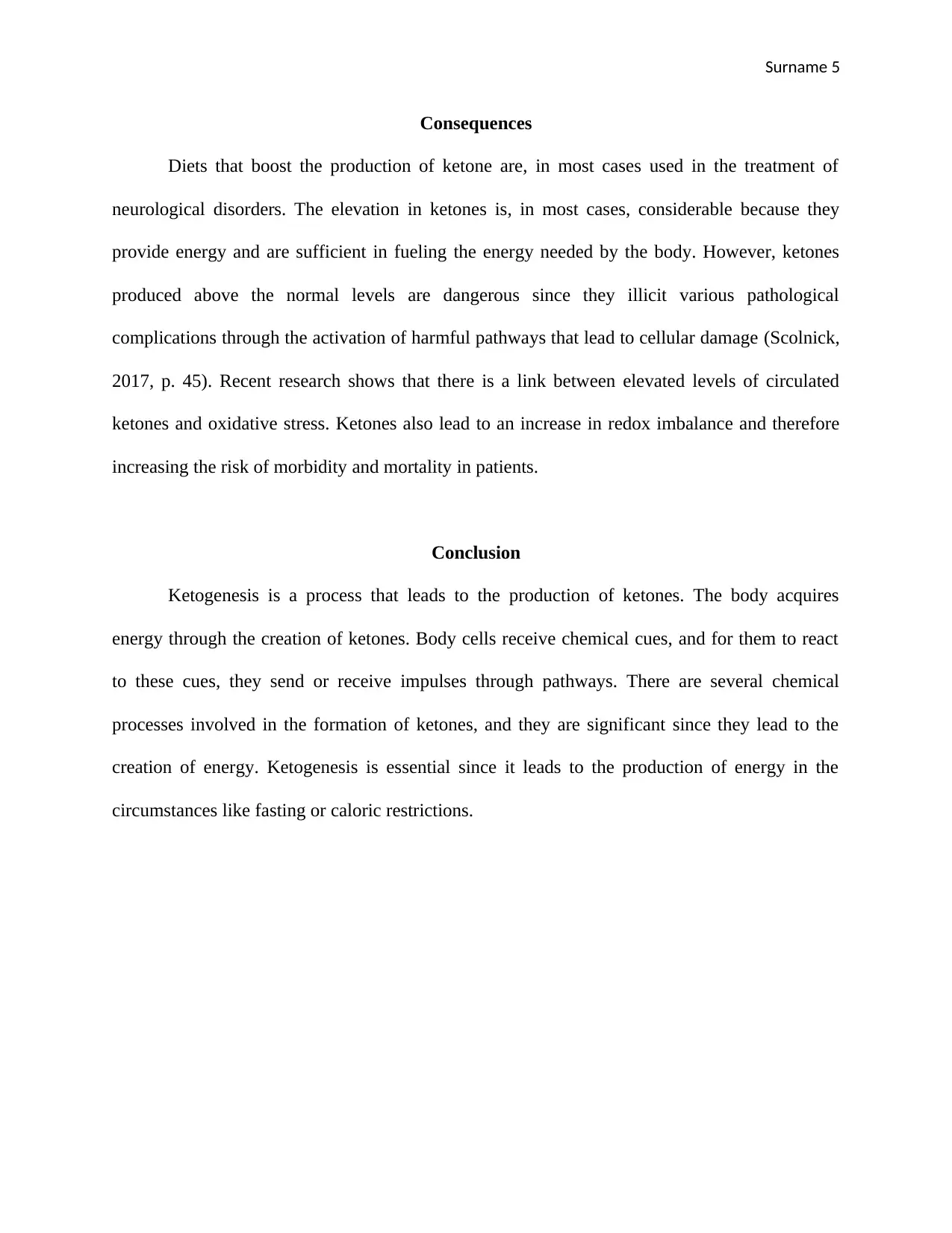
Surname 5
Consequences
Diets that boost the production of ketone are, in most cases used in the treatment of
neurological disorders. The elevation in ketones is, in most cases, considerable because they
provide energy and are sufficient in fueling the energy needed by the body. However, ketones
produced above the normal levels are dangerous since they illicit various pathological
complications through the activation of harmful pathways that lead to cellular damage (Scolnick,
2017, p. 45). Recent research shows that there is a link between elevated levels of circulated
ketones and oxidative stress. Ketones also lead to an increase in redox imbalance and therefore
increasing the risk of morbidity and mortality in patients.
Conclusion
Ketogenesis is a process that leads to the production of ketones. The body acquires
energy through the creation of ketones. Body cells receive chemical cues, and for them to react
to these cues, they send or receive impulses through pathways. There are several chemical
processes involved in the formation of ketones, and they are significant since they lead to the
creation of energy. Ketogenesis is essential since it leads to the production of energy in the
circumstances like fasting or caloric restrictions.
Consequences
Diets that boost the production of ketone are, in most cases used in the treatment of
neurological disorders. The elevation in ketones is, in most cases, considerable because they
provide energy and are sufficient in fueling the energy needed by the body. However, ketones
produced above the normal levels are dangerous since they illicit various pathological
complications through the activation of harmful pathways that lead to cellular damage (Scolnick,
2017, p. 45). Recent research shows that there is a link between elevated levels of circulated
ketones and oxidative stress. Ketones also lead to an increase in redox imbalance and therefore
increasing the risk of morbidity and mortality in patients.
Conclusion
Ketogenesis is a process that leads to the production of ketones. The body acquires
energy through the creation of ketones. Body cells receive chemical cues, and for them to react
to these cues, they send or receive impulses through pathways. There are several chemical
processes involved in the formation of ketones, and they are significant since they lead to the
creation of energy. Ketogenesis is essential since it leads to the production of energy in the
circumstances like fasting or caloric restrictions.
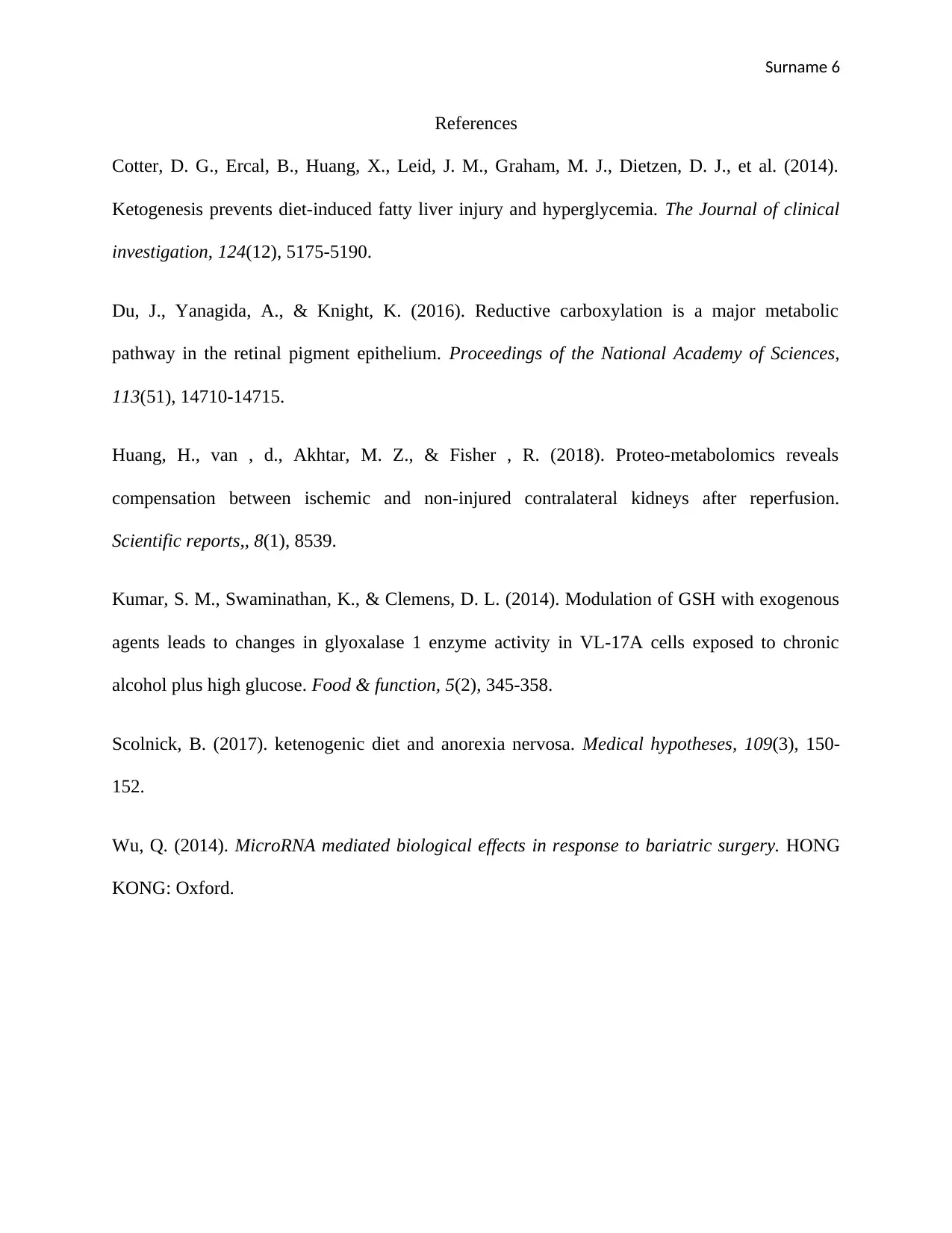
Surname 6
References
Cotter, D. G., Ercal, B., Huang, X., Leid, J. M., Graham, M. J., Dietzen, D. J., et al. (2014).
Ketogenesis prevents diet-induced fatty liver injury and hyperglycemia. The Journal of clinical
investigation, 124(12), 5175-5190.
Du, J., Yanagida, A., & Knight, K. (2016). Reductive carboxylation is a major metabolic
pathway in the retinal pigment epithelium. Proceedings of the National Academy of Sciences,
113(51), 14710-14715.
Huang, H., van , d., Akhtar, M. Z., & Fisher , R. (2018). Proteo-metabolomics reveals
compensation between ischemic and non-injured contralateral kidneys after reperfusion.
Scientific reports,, 8(1), 8539.
Kumar, S. M., Swaminathan, K., & Clemens, D. L. (2014). Modulation of GSH with exogenous
agents leads to changes in glyoxalase 1 enzyme activity in VL-17A cells exposed to chronic
alcohol plus high glucose. Food & function, 5(2), 345-358.
Scolnick, B. (2017). ketenogenic diet and anorexia nervosa. Medical hypotheses, 109(3), 150-
152.
Wu, Q. (2014). MicroRNA mediated biological effects in response to bariatric surgery. HONG
KONG: Oxford.
References
Cotter, D. G., Ercal, B., Huang, X., Leid, J. M., Graham, M. J., Dietzen, D. J., et al. (2014).
Ketogenesis prevents diet-induced fatty liver injury and hyperglycemia. The Journal of clinical
investigation, 124(12), 5175-5190.
Du, J., Yanagida, A., & Knight, K. (2016). Reductive carboxylation is a major metabolic
pathway in the retinal pigment epithelium. Proceedings of the National Academy of Sciences,
113(51), 14710-14715.
Huang, H., van , d., Akhtar, M. Z., & Fisher , R. (2018). Proteo-metabolomics reveals
compensation between ischemic and non-injured contralateral kidneys after reperfusion.
Scientific reports,, 8(1), 8539.
Kumar, S. M., Swaminathan, K., & Clemens, D. L. (2014). Modulation of GSH with exogenous
agents leads to changes in glyoxalase 1 enzyme activity in VL-17A cells exposed to chronic
alcohol plus high glucose. Food & function, 5(2), 345-358.
Scolnick, B. (2017). ketenogenic diet and anorexia nervosa. Medical hypotheses, 109(3), 150-
152.
Wu, Q. (2014). MicroRNA mediated biological effects in response to bariatric surgery. HONG
KONG: Oxford.
⊘ This is a preview!⊘
Do you want full access?
Subscribe today to unlock all pages.

Trusted by 1+ million students worldwide
1 out of 6
Your All-in-One AI-Powered Toolkit for Academic Success.
+13062052269
info@desklib.com
Available 24*7 on WhatsApp / Email
![[object Object]](/_next/static/media/star-bottom.7253800d.svg)
Unlock your academic potential
Copyright © 2020–2025 A2Z Services. All Rights Reserved. Developed and managed by ZUCOL.


